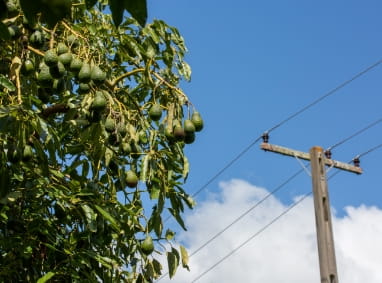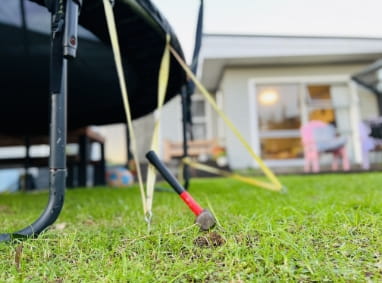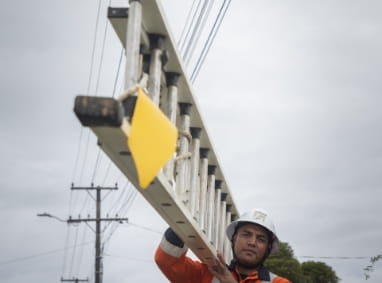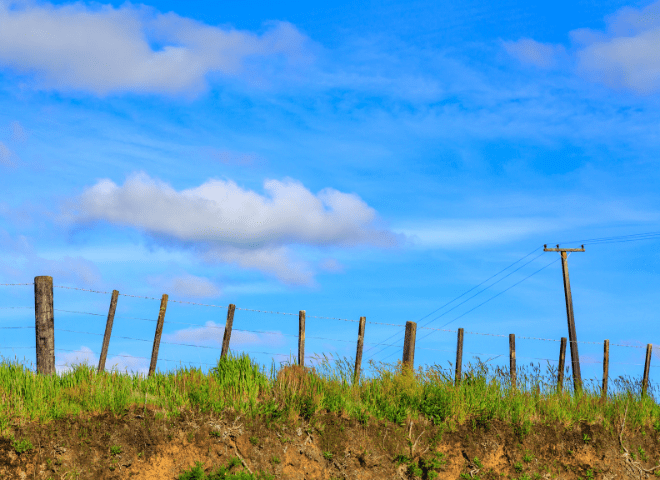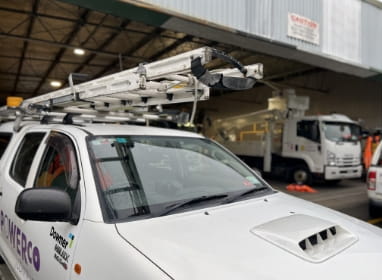Working near overhead lines
When carrying out any type of work near power lines, treat the lines as live at all times.
It’s important to keep yourself and any equipment you’re using – such as ladders, gardening tools, rollers and scissor lifts – at least 4 metres away from the overhead lines to help stay safe. This is because electricity can jump through the air to your equipment and to you.
Getting too close to power lines can cause serious injury and death. Troy Hall suffered life-long injuries after he worked too close to power lines. Watch his story here.
If you must work near power lines, you should have a designated observer who can watch out for any potential hazards and help keep you and your equipment well clear of the power lines.
If you’re needing to work within 4m of overhead lines, you’ll need a close approach consent. We’ll send someone to assess your site, inform you of safety requirements of working near the lines and other electrical equipment, and issue the permit to do the work near our assets.
Supporting links
Look up!
Overhead power lines are part of our landscape, however, to stay safe, it’s important to look up, know where they are and avoid being complacent around them. Holding an object that’s touching a power line can cause serious injury or death. To help avoid harm, keep yourself and any equipment you’re using at least 4m from power lines. Learn what to do – and not do – to stay safe around power lines. It could save your life.
Don’t try to touch or retrieve anything touching a line such as kites, balloons, drones, tree branches or other wires. Call us 0800 769 372
Tie trampolines down so they don’t blow into lines in high winds. Make sure tree forts, rope ladders and swings are only in trees that are a safe distance from lines.
Use an approved contractor
If a tree is within 4m of a line, do not cut it yourself. To stay safe, you must use an approved contractor to have it trimmed.
Check where lines are before raising equipment such as ladders, cherry pickers, tractors or truck beds. And lower lifting equipment before moving it. When moving tall machinery or vehicles, make sure you have at least 4m clearance under lines.
Erect wire farm fences away from overhead lines. People have been killed when fencing wire has snapped and flicked into lines.
When moving tall machinery or vehicles, make sure you have at least 4m clearance under lines. Park vehicles and work clear of lines when on the upper levels of trucks or high loads, and keep flag poles, tent poles and boat mast well away from lines.
Your electricity assets
We own and maintain the network of lines and cables that bring electricity to your boundary. You own and are responsible for the overhead service line or underground cable that brings power from our network to your property. You also own and maintain the electrical wiring inside your house.
You must use a Powerco contractor if you have a fault or need maintenance on your service line.
Always use a registered electrician to do wiring inside your house.
Safety disconnections
Arrange a temporary disconnection if you’re doing anything near a service line – that’s the line that connects a building to the pole on the roadside.
Contact your retailer (the company you pay your power bill to) to arrange your temporary disconnection. If your disconnection is during business hours, it will be free. Your retailer will need at least 24 hours notice.
If there's been an incident (such as a storm or a power surge) we may disconnect the power to your property for safety reasons. Here's how you'll get reconnected.
-
Step 1
We'll let you know you've been disconnected
A Powerco-approved contractor will leave a disconnection notice at your property to let you know you’ve been disconnected for safety reasons. -
Step 2
We’ll send someone to check your property
We’ll organise an electrical inspector to check your meter and switch board.
The inspector will reconnect you if it’s safe. -
Step 3
Work with your retailer or engage an electrician if there’s damage
If the meter board has been damaged, contact your retailer (the company you pay your power bill to) and they’ll have it fixed. Your retailer owns your meter board, which tracks how much power you use.
If your service line or internal wiring has been damaged, you may need a registered electrician to have it fixed. We’ll let you know if that’s the case.
You’ll be issued with a Certificate of Verification (CoV) or Certificate of Compliance (CoC) once work is complete.
-
Step 4
Call your retailer
Call your retailer to have your power reconnected.
You’ll need to:
Quote your disconnected tag number (on your disconnection notice from step one).
Have your CoV or CoC ready for the contractor when they arrive at your property to reconnect you.

